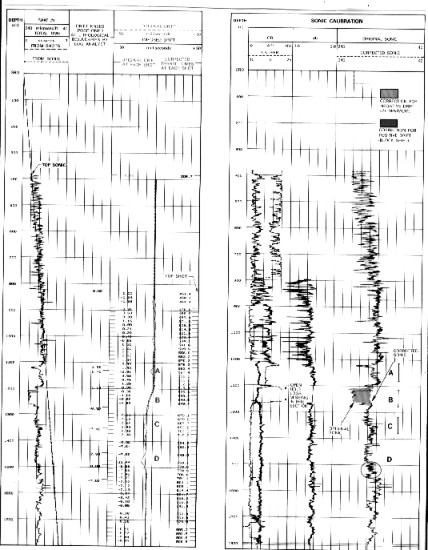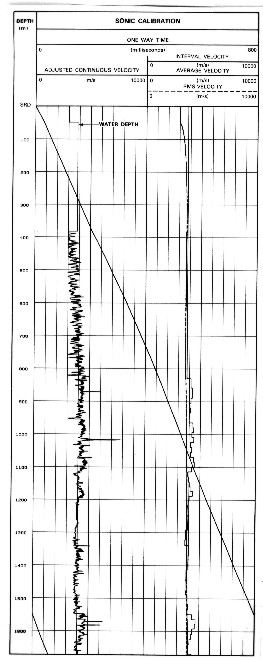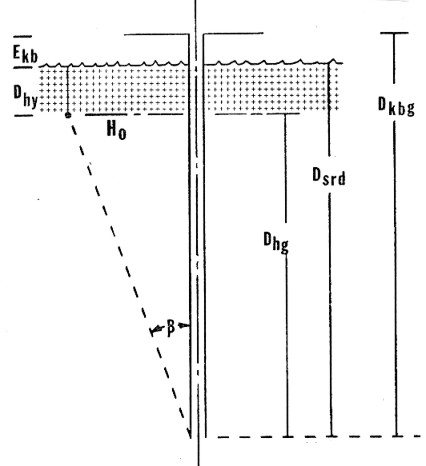|
 Seismic Check Shots
Seismic Check Shots
The seismic reference survey (SRS), often called a seismic check
shot survey, is designed as a calibration mechanism for
reflection seismic data. In such a survey, seismic velocities
are measured in the borehole by recording the time required for
a seismic pulse generated by a surface energy source to reach a
geophone anchored at various levels in the borehole.
Conventional surveys use a single geophone enclosed in a
pressure housing.
Older check shot (seismic reference survey) data should be used
with extreme care. Experience has shown that time breaks and
first break times are often difficult to pick and adjusting the
log to such data is sometimes worthless. This problem is
complicated further in deviated holes. Modern vertical seismic
profiles and multi-geophone borehole seismic strings suffer from
fewer problems than checkshot surveys because they use digital
timing circuits and digital data recording.
Recent advances have made it possible to use a series of
geophones spaced equally along a cable. More flexibility in
geophone placement and closer spacing between recordings is
achieved with this approach. On early versions, recording was
analog so only first breaks were picked to obtain travel time
and hence velocity to a depth.
Currently, vertical seismic profiles are made, which record the
full seismic trace received downhole at each detector. Automatic
first break detection provides the time-velocity-depth data, and
a properly processed display of traces is a relatively noise
free seismic section near the wellbore.
The
recorded travel times are used to calibrate the sonic log, which
then becomes the basic seismic calibration reference. A time
versus depth plot is produced from these data.
The calibrated sonic and the density logs are used to construct a synthetic seismogram, which
allows identification of reflecting horizons by reference to the
seismic response at the wellbore.

Seismic Reference Survey (Checkshots) and
computed results

Sonic calibrated to SRS checkshots and
reconstructed density log
  Time to Depth conversion from SRS checkshots Time to Depth conversion from SRS checkshots
The
tool lowered into the borehole consists of:
- velocity sensitive geophones
- amplifier circuits
- hydraulic anchoring system
At
the surface, there will be:
- air guns
- air compressor
- reference hydrophone
- extra surface hydrophones if required
- high speed recorder (self developing film)
- control panel (amplifiers, filters)
- digital tape recorder
The
anchored geophone permits releasing cable tension, thus
eliminating transmission of much of the surface generated noise.
This allows the use of an air gun as a power source thereby
obviating explosives and all the attendant safety hazards and
logistical complications.
The
entire well shooting operation can be carried out by the same
crew that performs the logging operation thus simplifying
personnel movements. Surveys can be run in open or cased (single
string) hole.
The
geometry of an SRS survey is shown below. The
calculations take raw arrival times (slant path) and convert
them to vertical (straight ray) paths.
 Checkshot geometry
==> Checkshot geometry
==>
For
straight hole:
1: Dhg = Dkbg - Ekb -
Dhy
2: Tv = Ts * COS (ARCTAN
(Ho / Dhg))
For deviated hole:
3: Hhg = Hg^2 + Ho^2 -
2 * Hg * Ho * COS (AZM)
4: Tv = Ts * COS (ARCTAN
(Hhg / Dhg))
In
either case:
5: Dsrd = Dkbg - Ekb
And for any two tock layers:
6: Vint = 2 * (Dsrd2 -
Dsrd1) / (Tv2 - Tv1)
Where:
AZM = azimuth of hydrophone
from surface location of well minus the azimuth of the
geophone from the surface location of the well (degrees)
Dhg = depth below hydrophone to geophone (ft or m)
Dhy = depth of hydrophone below seismic reference datum (ft or m)
Dkbg = depth below kelly bushing to geophone (ft or m)
Dsrd =
depth below seismic reference datum to geophone (ft or m)
Ekb =
elevation of kelly bushing relative to sea level (ft or m)
Hg = horizontal offset of
geophone from surface location of well (ft or m)
Hhg = horizontal distance from hydrophone to geophone in deviated well
(ft or m)
Ho = horizontal offset
of shot location to well location (ft or m)
Ts =
slant path time (sec)
Tv =
vertical time (sec)
Vint =
rock layer interval velocity (ft/sec or m/sec)
These calculations provide one-way times versus depth and
interval velocities which can be compared to those derived from
sonic logs or seismic data. Similar results are also obtained
from VSP data.
|

